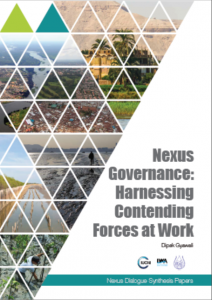For many rural farmers, fishers, and community groups, food, water and energy resources are not considered as separate pillars but are part of the system they live and work in and need to be managed accordingly. Therefore, at the local level, the nexus is a practical everyday reality. However, the conceptual separation and consequent management of these resources is what has happened in the world of experts and government bureaucracies.
Using case studies from Nepal, India and Thailand, this paper explores challenges and governance options that can accept social and physical uncertainties and build synergy across the water, energy, and food sectors. Examples from Nepal, focusing on its only large storage reservoir, the Kulekhani, and its biggest inter-basin water transfer project, the Melamchi, are used to illustrate what unintended consequences a silo approach, either by design or default, can have.
Given the historical lack of success of previous efforts at ‘integrated management’ there is a need to ask how the water, energy, food policy terrain can be expanded to allow for a wider range of institutional voices at different hierarchies to be included. Often they may define the nexus ‘problem’ very differently. Nexus thinking can be encouraged either by leadership or shocks to the ‘system’, both of which can be taken advantage of if they arise. In normal mundane times, opening silo-based approaches can be encouraged by a process of constructive engagement between plural voices of different styles of organizing – hierarchism, individualism and egalitarianism – and at levels from the village commons to the national and regional levels.
This has the advantage of structurally bringing different concerned parties into a horizontal discussions rather than one that is normally vertical, hierarchical and top-down. Information and joint opportunities can then be easier to identify, allowing silos to be linked, i.e. ‘nexused’. Based on the case studies presented in this paper, what remains clear is that dominance, or an unequal balance in favour of hierarchies and against the other two, can lead to the creation of problems for different sectors and often missed opportunities across sectors.
Binding common objectives across institutions and down through sectors through appropriate indicators for example can help to send clear messages to donors and investors regarding clear multi-objective investments that should make them question their own silos. It is compromises with sectors and silos that will lead to better outcomes across sectors.


